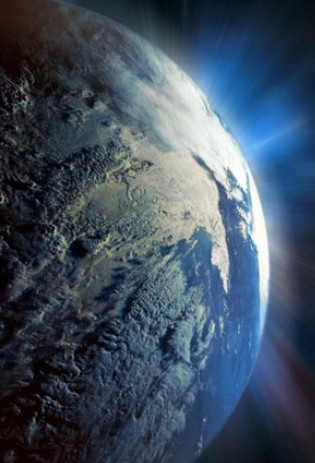(单词翻译:单击)

Technology Going underground
科技 去地球深处
A project to reveal more about all the carbon on Earth
一个将会揭示更多关于地球上所有碳的秘密的项目
THE carbon cycle is the stuff of school books.
碳的循环在学校教科书中已经讲过了。
It is a familiar tale of photosynthesis, forests, farming and fossils fuels.
这是一个包含光合作用,森林,农业及化石燃料等且为人所熟知的故事。
Understanding this cycle is important, both because it sustains life on Earth and because it is bound up with the rate of global warming.
理解这个循环是重要的,既因为它支撑了地球上的生命又因为它和温室效应息息相关。
But are the outlines of the carbon cycle really that familiar?
但是碳循环真的就像我们所熟悉的那样子么?
At the AAAS meeting in Washington, DC, Robert Hazen of the Carnegie Institution for Science, which is based in the same town, gave a lecture intended to show that this view of the carbon cycle only scratches the surface.
在华盛顿特区召开的AAAS会议上,来自位于该特区卡耐基科学研究所的Robert Hazen做的研究试图展示出以前那种碳循环的观点仅仅是抓了些表面现象。
Dr Hazen is one of the moving spirits behind a project called the Deep Carbon Observatory, which will be paid for by the Alfred P. Sloan Foundation.
Hazen博士是一个叫做地底碳观察项目的策划人,这个项目即将得到Alfred P. Sloan基金会的资助。
Over the course of the next decade it will attempt to understand all the carbon in the Earth, not just the stuff that cycles through the atmosphere, the oceans and living things.
在接下来的10年里,该项目将会致力于理解地球上所有碳的循环方式而不仅仅是大气,海洋和生物中循环的那些碳的运转。
As Dr Hazen pointed out, carbon is the fourth-most-abundant element in the universe, after hydrogen, helium and oxygen.
就像Hazen博士指出的那样,碳是宇宙中含量排第四的元素,仅落后于氢,氮和氧。
In the Earth, though less common than that, it is reckoned to make up between 0.07% and 3.2% of the planet.
虽然在地球上它的含量并没有这么高,但是据估计,它应该占星球的0.07%-3.2%。
But the uncertainty of this range is itself a comment on how little carbon's role in the Earth's overall physics and chemistry is understood.
有这个范围区间正表现出碳在整个地球物理化学研究中被忽视了。
Also uncertain is how much interchange there is between the carbon in the Earth's mantle and core, and the more familiar stuff in the crust, atmosphere and oceans.
地表和地心之间碳的交流以及地壳、大气和海洋之间碳的交流目前人们都不明确。
Some carbon comes from the mantle to the surface in the form of diamonds.
有些来自地幔的碳以钻石的形式到达地表。
These crystals, which can form only under the intense pressure of the Earth's deep interior, must have been erupted at unbelievable speed (about 100kph) to have survived the journey to the surface intact.
这些只有在地球内部巨大的压力下才能形成的晶体,需要以令人难以置信的速度(100公里每小时)喷出地表才能保持完整。
At slower speeds they would have turned into graphite, much to the chagrin of brides-to-be everywhere.
如果速度较低,他们会变成石墨,这是得那些即将成为新娘的人十分懊恼。(钻石很珍贵而结婚的新娘们很喜欢但因为它们因为速度的原因就不能形成钻石,所以很懊恼)
How, exactly, diamond forms is an important question. Diamonds are useful as an industrial material as well as gem stones, and they would have many more applications if they could be made cheaply. And another, even more important industrial material, petroleum, may also come from the mantle.
钻石到底是怎么形成的是一个重要的问题。钻石不仅仅是宝石首饰,而且是重要的工业材料。如果可以很便宜的制作的话,它的使用会更加广泛。另外一种更加重要大的工业材料,石油,同样是来自地幔。
Among petroleum geologists in Western countries, the consensus is that crude oil and natural gas are formed near the Earth's surface from the fossilised bodies of living organisms.
西方地质学家认为,石油和天然气是生物石化的尸体在地表附近形成的。
Many Russians, though, disagree. They support the 130-year-old idea of their countryman Dmitri Mendeleev (who created the first version of the periodic table of elements).
很多俄国科学家则不这么看。他们支持同胞门捷列夫的有130年历史的观点。
He thought the temperatures and pressures of the mantle would convert carbonates and water into hydrocarbons.
门捷列夫认为,地幔的温度和压力可以把碳酸盐和水转化成碳氢化合物。
That has, indeed, been done experimentally in the past.
的确,这在过去被试验过。
And one role of the Deep Carbon Observatory will be to try to do it again in more sophisticated ways.
地底碳观察的一个任务是用更精确的方法重复这个实验,
If it turns out that fossil fuels are abiogenic, that probably means they are more abundant than Western geologists think, and may be found in places hitherto thought unpromising.
如果最终证明化石燃料是和生物无关的,那意味着它们的存在可能比西方地质学家们想的更加广泛,可能在以前认为不可能的地方存在。
Abiogenic petroleum could also provide food for one of the most intriguing targets of all for the Deep Carbon Observatory: the bacteria that live in the Earth's depths.
非生物化的石油也可以为地底碳观察最刚兴趣的对象--地底细菌,提供食物。
Current estimates suggest that half of all the living matter on Earth lives underground, at depths of up to 5km.
现在估计地球上大约一半的生物生活在地下深度约5千米以下的地方。
Some people think the share may be bigger than that. Indeed, there is loose talk of life having originated more than once in the distant past, and of there being entire shadow biospheres of organisms completely unrelated to anything on the surface.
有些人认为比例可能更大。的确,有关于生命不止一次的在不久的过去重新起源的讨论,以及关于存在与地表无关的地底阴影生物圈的讨论。
Intriguingly, a few diamonds bear signs that their carbon was once part of living organisms.
有趣的是某些钻石有着一些它们可能曾经是生物的迹象。
The ratio between the heavy and light isotopes of the element in their crystals is not quite right for stuff that has come out of the ground.
它们晶体里重轻同位素的比例并不像是从地底挖出来的东西那样。
Instead, it matches the ratio found when organic molecules have been through a few rounds of biochemical processing.
与之相反,它们与生物分子经过生化处理后表现出的比率相吻合。
Clearly there is a lot going on deep in the Earth that is completely unknown to science.
很显然,地下深处正在发生的很多事情科学对其是一无所知的。
With a bit of luck, over the ten years of Dr Hazen's project, the veil of ignorance will be lifted a little.
如果幸运的话,十年之后Hazen博士的项目将会帮我们减少这方面的无知。


